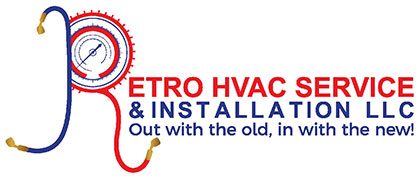
Ceiling fans are one of the most overlooked ways to enhance comfort and cut energy costs. By boosting air circulation and assisting your HVAC system, ceiling fans and energy efficiency are truly a perfect combination. They offer a smart, cost-saving way to stay cool while lessening strain on your AC—helping you avoid unnecessary air conditioning repair.
In this blog, the experts at Retro HVAC Service & Installation discuss how ceiling fans can make your home feel more comfortable while saving you money thanks to increased HVAC efficiency. We'll also offer some HVAC efficiency tips that put to good use ceiling fans.
Comfort vs. Temperature: Staying Cool Using the Wind-Chill Effect Indoors
Ceiling fans don’t actually change the room’s temperature—they make your home more comfortable by blowing air across your skin. This is called the wind-chill effect, and it can make a room feel up to 4 degrees cooler without adjusting the thermostat. That means you feel less hot and enjoy the benefits of indoor air circulation from your ceiling fan while minimizing air conditioner use—helping reduce your electric bill in summer.
The Best of Both: Advantages of Pairing Fans and Air Conditioning Together
There are several benefits to using ceiling fans and air conditioning in tandem, especially when it's very hot outside. By using both, you increase HVAC efficiency and keep your home cooler with less strain from your cooling system.
Why you should use ceiling fans and AC together:
- Ceiling fans help lower HVAC load by circulating cool air more evenly throughout the room. Limiting HVAC stress is important, because it can help you avoid a breakdown that could lead to premature AC or furnace installation.
- Using overhead fans improves your indoor comfort by eliminating hot spots and increasing airflow.
- Combining ceiling fans and AC can cut energy consumption. If you have a home automation system, you can even modify your smart thermostat settings to set the temperature higher while your ceiling fan is running.
Clockwise vs. Counterclockwise Ceiling Fan Rotation: Which is the Correct Direction?
To maximize the benefits of your ceiling fans year-round, it’s important to ensure blades are rotating in the proper direction for the season. The direction influences how air moves, which can either cool you down or push warm air downward so you feel warmer.
When to spin ceiling fans counterclockwise
In the summer, ceiling fans should rotate counterclockwise at a quick speed. This creates a breeze that pushes cool air downward, enhancing the wind-chill effect and making you feel cooler.
When it's best to spin ceiling fans clockwise
When it's cold out, set your fan to turn clockwise on a low speed. This softly moves cold air up and circulates heated air down to where you can feel it, helping you feel warmer without adjusting your thermostat.
Things to Look for in a Ceiling Fan
Picking the right ceiling fan depends on a few critical considerations, including blade design, airflow rating and room dimensions. First, look for fans that have a good combination of ECFM airflow and blade pitch to deliver efficient air circulation in your home:
- ECFM is how much air a fan circulates—the cubic feet per minute, or CFM—per watt of electricity consumed. Fans with greater ECFM are the most energy efficient.
- Blade pitch is the incline of the blades. A steeper blade pitch increases airflow but can also strain the motor.
Also, consider room size when sizing a ceiling fan—a fan that’s too small won’t circulate sufficient air, while one that’s too big may be too strong for the space.
Boost Your HVAC Efficiency With the Experts from Retro HVAC Service & Installation
At Retro HVAC Service & Installation, our HVAC technicians can help you enjoy year-round comfort while reducing strain on your heating and cooling systems. From efficient ceiling fan strategies and air conditioning installation to smart thermostats and furnace repair, we offer comprehensive services that fit your lifestyle. Schedule your appointment by calling 267-485-6219 today.
